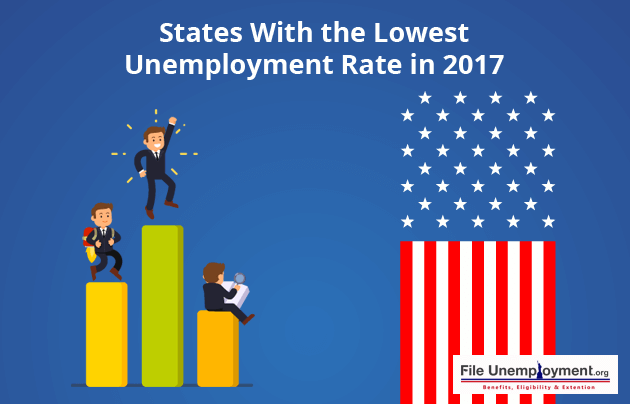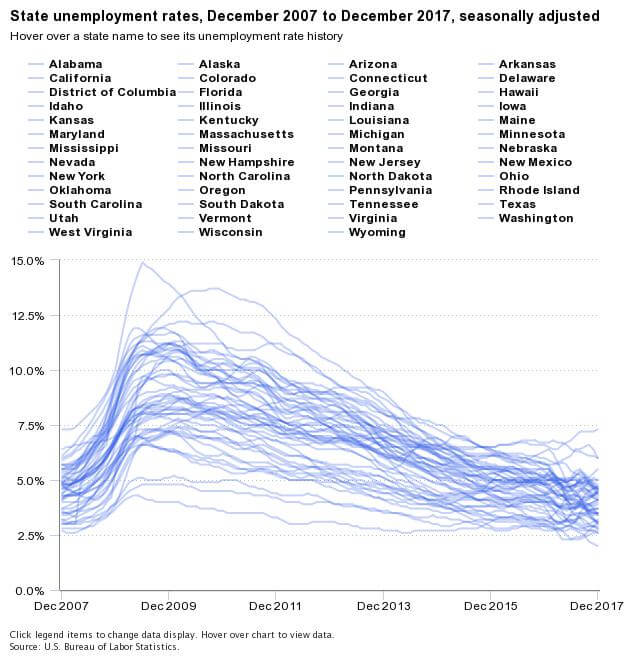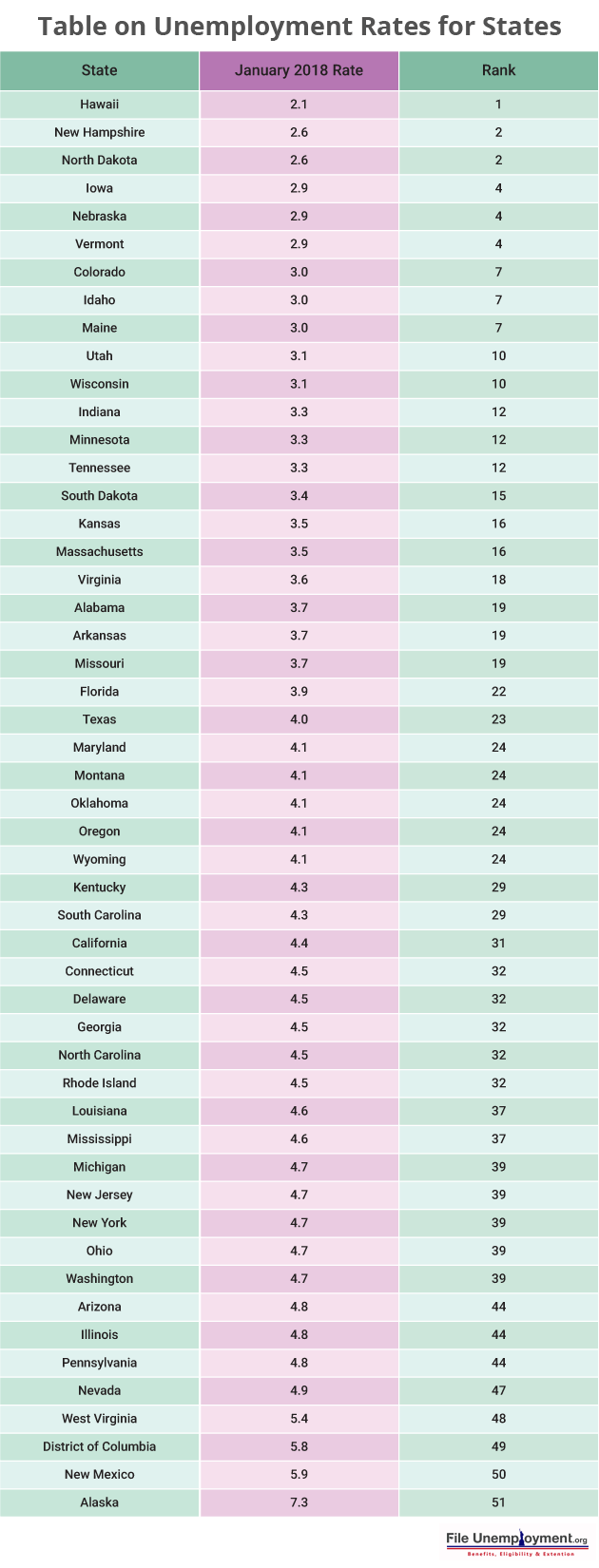Since the last report by the Bureau of Labor Statistics, US unemployment remained unchanged at 4.1 percent in February 2018. This remained at a 17 year low and slightly above the 4 percent market expectation. In the best states employment holds 30 percent of the weight in the ranking of the economy. In order to evaluate the economy, it can be based on three major metrics which include labor force participation rate, job growth, and unemployment rate. The labor force participation rate measures the percentage that employed or actively looking for a job. The unemployment rate is measured by the percentage of the labor force which is out of a job. These three metrics indicate the employment and economic prospects in the state.
The number 1 state for employment is Hawaii which is followed by North Dakota, Colorado, and Utah. You should also know that the worst state for jobs is West Virginia and it followed by New Mexico, Kentucky, Mississippi, and Louisiana. Even though California ranks 29th in the ranking, it has the 4th best economy because it ranks in the top five for both growth and business environment, and in two subcategories it is the Best States for the economy.
While the number of unemployed increased by 22,000 to 6.71 million, employment rose by 785,000 to 155.22 million. In this time, the total labor force participation rate rose by 0.3 percentage points to 63 percent which is the highest in 5 months. While the unemployment rate averaged at 5.79 percent until 2018, the all-time high reached 10.8 percent in November 1982 and the record low of 2.5 percent in May 1953.
Change in Unemployment Rate
Based on this metric, you can evaluate the compound annual growth rate of nonfarm jobs over three years from 2013 to 2016 based on employment and the number of new jobs created. Far West and the Rocky Mountains had experienced the highest job growth rates while places in the Plains and Mid-Atlantic states had struggled. There were only four states which boasted of a growth of more than 3 percent. These states included Delaware, Arizona, and Oregon. Unlike these states, five states had negative growth rates: Wyoming, West Virginia, Alaska, Vermont, and Nebraska.
As of December 2017, Hawaii and North Dakota had the lowest unemployment rates in the country and it is followed by New Hampshire and Nebraska. Half of these 10 states had the highest unemployment rates and this included regions in the Southeast and Southwest. Out of all states, Alaska ranked No. 50 with a 7.2 unemployment rate. But in this period unemployment rate was at 4.1 percent with the lowest in the Rocky Mountain and the regions in the Great Plains.
In February, the number of long-term unemployed remained almost unchanged at 1.4 million and accounted for 20.7 percent of the unemployed. In the last year, the total long-term unemployed was down by 369,000. Also, in the same month, the civil labor force rose by 806,000. Total employment rose by 785,000 and hence the employment-population ratio increased by 0.3 percentage point to 60.4 percent and the last four months have seen little change. Also, those that worked part-time for economic reasons and this changed slightly at 5.2 million. Though these individuals would have preferred full-time employment and working part time because hours were cut or they were unable to find full-time jobs.
Also, in February, there were 1.6 million people that were marginally attached to the labor force was a little different from the earlier year. Some individuals were not part of the labor force but were available for work and looked for work in the last 12 months. They were earlier counted as unemployed as they did not search for a job in the last 4 weeks. There were also 373,000 discouraged workers which is down 149,000 from the previous year. There were discouraged workers that believed that there were no jobs and hence were not looking for jobs. Finally, the remaining 1.2 million persons that were marginally attached to the labor force had not searched for a job because of family responsibilities or school attendance.
This chart explains the Unemployment Rate for last ten year till 2017
Important Factors On Unemployment Rate
Here are some of that help in determining unemployment and the unemployment rate:
Healthcare
In the best states, healthcare is worth one-third of the weight of the ranking. There are 6 metrics that contribute to the rankings. These include child wellness visits, health insurance enrollment, adult wellness visits, adult dental visits, child dental visits and health care affordability. There are many Americans that have access to quality healthcare while others face barriers like a lack of insurance and things that prevent them from receiving basic health services. This lack of access to quality healthcare has increased the public health and financial burden on the state residents and the population on the whole.
Massachusetts has the best healthcare access but ranks fifth in healthcare and No. 8 overall state. Hawaii is the No.1 state in healthcare and is second in healthcare access. Four New England states make up the Top 10 which include Connecticut, Vermont, Rhode Island and New Hampshire. In the US, the worst state for healthcare access is Alaska but it ranks fourth in healthcare quality. Finally, six of the bottom 10 states for healthcare access are Mississippi, Florida, Oklahoma, Texas, Georgia, and Alabama.
When it comes to dental care, this metric determines the percentage of adults that do not visit a dental clinic for any reason like visiting a dentist, dental hygienist or dental specialist, within the past year. There is data that suggests that around 34 percent of adults do not visit the dentist and 26 percent are from New England while 40 percent are from the Southwest. While New England states comprised of the three of the top five states, 22 percent comprised of people from Connecticut which had the smallest percentage of those that did not visit dental clinics. Louisiana ranked at No. 50 for adult dental visits with 43 percent of adults that did not visit a dental clinic in the past year.
Education
Higher Education takes up to half of the weightage of the education rankings. This metrics involves the numbers of citizens in each state that hold a college degree. There is a wide variance based on the states and regions. Massachusetts had ranked No. 8 among all the best states which was 10 percentage points than states in the Southwest and Southeast. This ranking will also account for the time that it takes for students to complete both the two and four-year college programs. This includes the cost of tuition, fees structure by state and the burden of debt that the college graduates have to face. South Dakota has the highest percentage of students that complete a two-year college degree within 3 years at 61 percent. Vermont has the highest average college in 2016 at $15,000 a year while Wyoming had the lowest cost at about $4,175 a year. In terms of the smallest debt burden, Utah averaged at less than $20,000 per student and the biggest debt burden, New Hampshire students were set back at more than $36,000 on average.
Opportunity
In terms of opportunity, forty percent of the weightage is given to measurements of opportunity based on the economic opportunity. The percentage of households living below the poverty line is the lowest in Mississippi. Based on metrics like food insecurity, children and adult count and those that do not get adequate nutrition, Mississippi and North Dakota rank the lowest. This takes into account the median household income in every state with Maryland’s ranking at the highest. It also gauges the disparity of income between the lowest income households and the highest. Alaska shows the smallest disparity between rich and poor. Four metrics are indicators that judge things beyond economic opportunity. These include employment, stability, health and the effect of quality of life in the state’s population. The No. 1 state for economic opportunity is New Hampshire and this is followed by Alaska, Maryland, Hawaii and North Dakota. While the best state overall was Iowa, it was ranked as 15 in this subcategory. The 15 states at the bottom of the list for economic opportunity include Southeast and Southwest states like Arkansas, Louisiana, Alabama and Mississippi.
Infrastructure
The condition of infrastructure is key to evaluating the quality of life for all Americans. When it comes to ranking the best states for infrastructure, quality of roads, bridges and the use of renewable energy. Even though the US is among the list of the top nations for education, quality of life and entrepreneurship, it lags behind considerably in infrastructure.
The condition of infrastructure is key to evaluating the quality of life for any state’s citizens. In ranking the Best States for infrastructure, use of renewable energy and the quality of roads and bridges were major considerations. While the U.S. is among the top nations for education, entrepreneurship, and quality of life, it lags behind in infrastructure, earning a D+ in the American Society of Civil Engineers 2017 report card. There is a new $1.5 trillion plan by President Trump to rebuild bridges, ports, roads and other public works. But this plan has not seen the light of day since it is based on state and local funding and there is a shortage of skilled construction works which left post the period of recession and this has increase project costs. Iowa and North Dakota stand out as the best 2 states for infrastructure. The top 10 include most western and plains states like Utah and Idaho and half of these states are in the top 10 of overall best state rankings.
Crime and Correction
It is quite notable that crime in America has reached historic lows despite cities like Chicago, Charlotte and Baltimore seeing an increase in overall crime. Chicago accounts for less than 1 percent of all the US population but accounts for more than 20 percent of murders in 2016 alone. But, today the average person walking on the street is safer than 30 years ago. While the populations in state and federal prisons have seen a slow decline, the US imprisons more of its citizens than any other developed country. This has led to overpopulation in the prisons and the increase in the fiscal burden for states and this is disproportionate for affected minorities. A lot of states have a higher incarceration for minorities than Caucasians. While crime rates vary from state to state, there is a difference in how states deal with this issue from modernizing prisons to operating efficient correctional systems. New England states have the best crime and correction and Maine ranks No.1 and New Hampshire is a close second. But, more populous urban states like New Jersey and New York stand out of the rankings. In all of the top 10 states, New Hampshire, Massachusetts and Vermont rank in the top 10 best states.
Fiscal Stability
The Bill of Rights enumerated all the basic rights and not the US Constitution. This was the 10th Amendment that reserved an unspecified list of rights for states. Fiscal stability is important to ensure that the state’s government allows for government sponsored programs and projects that affect the quality of life to the state’s residents. Today, these rights and powers of the states have enabled a broad range of services to their citizens. This includes the delivery of public education, state administration, and the overall fiscal health. An amazing fact is that the economy of California is equal to that of France. The No. 1 state is Utah and second is North Dakota. There are several midwestern states that rank in the top 10 and include Indiana and Missouri. Others on the east coast that are top rated in fiscal stability are North Carolina and Florida.
Quality of Life
Finally, one of the most important indicators that have guided policymakers and determined regulations was based on the quality of life index. This would ensure that there is a safe relationship between the people and the environment. Regulations like the Clean Air Act, Environmental Protection Agency, Clean Water Act, Safe Drinking Water Act are some important measures introduced. This was done to help states properly dispose of pollutants at treatment plants and meet the federal standards of public drinking water. The main objective was to help preserve the state’s resources and protect the public from harmful toxins and other health concerns. People have time and again shown their support and made their voices heard to improve these Acts. North Dakota and Minnesota are the most effective at promoting their citizens’ well-being by providing both a healthy environment and a sense of social connectedness. In the list of top states, New Hampshire, Wisconsin, South Dakota and Mississippi feature. There are measures in place to regulate the drinking water quality, air quality, the natural environment and the total toxic chemical pollution per square. The ranking also checks the risk on citizens. Social environment plays an important role and investigates people are involved in their communities. Political involvement includes evaluating the average voter turnout for presidential and congressional elections.
You can explore this chart to determine how states are ranked in terms of unemployment.



